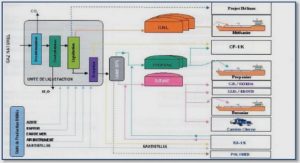Get Complete Project Material File(s) Now! »
CHAPTER 3 METHODOLOGY
“It is important to get results from experiment but the most important is the process in getting that results.” (Dr Nik Ahmad Nizam)
Introduction
Research is always aimed at the solution to a problem. The process of research, according to Leedy (1993), in Fouché & Delport, (2011), is largely circular in configuration, in the sense that it begins with a problem and it ends with the problem solved. Rigorous researchers bear in mind, however, that the Russian proverb trust, but verify underpins science in that results should always be subject to challenge from experiment. Research is based on some underlying philosophical assumptions about what constitutes ‘valid’ research, and which research methods are appropriate for the development of knowledge in a study. In order to conduct and evaluate any research, it is important to know what these assumptions are. It is essential that the appropriate and relevant research methodology is selected and applied, since the methodology often determines the outcome of the study (Myers, Gleason, Yoon & Kung 1997).
In addition to a discussion of the main aim and sub-aims, this chapter contains a focused and systematic examination of the underlying philosophical assumptions as evidenced in the hypotheses, applicable research design, and the research process including participant selection (population, sample, and information), description of participants, pilot study, material and apparatus for participant selection, procedure for participant selection, and data collection. The procedure for data interpretation and analysis, as well as the analysis of data are also discussed in this chapter. Reporting of ethical approval (ethics clearance) and informed consent in clinical research articles involving human subjects are mandatory. This chapter ends with a conclusion.
Aims of the study
Main aim: To determine the response of the central auditory nervous system (CANS) to sound in normal hearing adults with and without HIV/AIDS, using fMRI.
- Sub-aim one: To determine the response of the CANS (ROI)1 to nonsense syllables in normal hearing adults with and without HIV/AIDS, using fMRI.
- Sub-aim two: To determine the response of the CANS (ROI) to warble tones in normal hearing adults with and without HIV/AIDS, using fMRI.
- Sub-aim three: To compare the response of the whole brain to nonsense syllables and warble tones in participants with normal hearing with and without HIV/AIDS.
The hypotheses
A hypothesis is a tentative suggestion or preliminary statement about the relationship between two or more variables in the population being examined. The task of the researcher is to examine the research problem and find an appropriate explanation for it (De Vos, Strydom, Fouché & Delport, 2011). A quantitative study will start with a hypothesis, and then provide evidence to prove it true or false (Delport & de Vos, 2011). The null hypothesis (H0) predicts that there is no relationship between two measured phenomena. The alternative hypothesis (H1) is a supplement to the null hypothesis: it will predict a direction of change, an alteration, and a difference (Brewer & Stockton, 2010). The following hypotheses were proposed for this study:
- H10: There is no difference between the response (as measured with fMRI) of the CANS (ROI) to nonsense syllables in normal hearing adults with HIV/AIDS and in normal hearing adults without HIV/AIDS.
- H1a: There is a difference between the response (as measured with fMRI) of the CANS (ROI) to nonsense syllables in normal hearing adults with HIV/AIDS and in normal hearing adults without HIV/AIDS.
- H20: There is no difference in the response (as measured with fMRI) of the CANS (ROI) to warble tones in normal hearing adults with HIV/AIDS and in normal hearing adults without HIV/AIDS.
- H2a: There is a difference in the response (as measured with fMRI) of the CANS (ROI) to warble tones in normal hearing adults with HIV/AIDS and in normal hearing adults without HIV/AIDS.
- H30: There is no difference in the response of the whole brain to nonsense syllables and warble tones in participants with and without HIV/AIDS.
- H3a: There is a difference in the response of the whole brain to nonsense syllables and warble tones in participants with and without HIV/AIDS.
Research design
A research design is the outline of the overall research strategy that is to be used to ensure that the research problem is addressed effectively (Fouché & De Vos, 2011). The current research was quantitative, applied, and exploratory in nature (Leedy & Ormrod, 2010; Fouché & De Vos, 2011).
Quantitative methods emphasize objective measurements and the statistical, mathematical, or numerical analysis of data. Quantitative research focuses on gathering numerical data to explain a particular phenomenon (Babbie, 2013). Quantitative research implies an approach using variables. A sound quantitative design should only manipulate one variable at a time. The variable in this study was a two-valued (dichotomous) variable using people with HIV/AIDS and people without HIV/AIDS. Quantitative data can be statistically analysed to answer the research question. Thus, during this study, a quantitative approach was used primarily to analyse and interpret whether HIV/AIDS has an effect on the response of the CANS to sound when using fMRI (Fouché & De Vos, 2011). The advantage of quantitative research is that the methods used enable the comparison of measurements and data (Durrheim, 2002).
Applied research deals with solving practical problems, so as to provide evidence based practice (Fouché, 2011). The outcomes of this study may enhance diagnostic protocols, and indirectly contribute to improving service delivery to persons infected with HIV/AIDS.
Acknowledgements
Abstract
Table of Content
List of Figures
List of Tables
Chapter 1 Introduction and orientation
1.1. Introduction
1.2. Orientation to the study and background
1.3. Problem statement and rationale
1.4. Clarification of terminology and abbreviations
1.5. Outline of the thesis
1.6. Conclusion
Chapter 2 The influence of HIV on the auditory system and the principleS of using auditory fMRI
2.1. Introduction
2.2. HIV/AIDS and the human body.
2.3. Anatomy, physiology, and pathologies of the auditory system
2.4. HIV/AIDS in the peripheral auditory system and central auditory system
2.5. Assessment of CANS using fMRI
2.6. Conclusion
Chapter 3 Methodology
3.1. Introduction
3.2. Aims of the study .
3.3. The hypotheses.
3.4. Research design
3.5. Ethical clearance and informed consent
3.6. Participants: Population and sample
3.7. Data collection
3.8. Procedure for data collection for the experimental study
3.9. fMRI statistical analysis tests used
3.10. Trustworthiness of the current quantitative research project
3.11. Conclusion
Chapter 4 Results
4.1. Introduction
4.2. Results of sub-aim one
4.3. Results of sub-aim two
4.4. Results of sub-aim three:
4.5. Chapter summary
Chapter 5 Discussion of Results
5.1. Introduction
5.2. Discussion sub-aim one
5.3. The response of the CANS (ROIs) to nonsense syllables
5.4. The effect of CD4 count and ART on the activation (mean percentage signal change) in BA41 and BA42
5.5. Discussion sub-aim two
5.6. Discussion sub-aim 3:
5.7. Comprehensive conclusions
Chapter 6 Conclusions, Clinical Implications, and Recommendations
6.1. Conclusions
6.2. Limitations
6.3. Strengths and clinical implications of the research findings
6.4. Recommendations for future research
6.5. Final comment
References
Appendices
GET THE COMPLETE PROJECT






